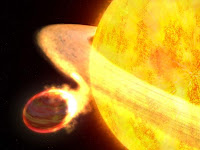Astronomy News - Hubble & Jupiter
The Hubble Space Telescope has captured evidence of a Sun-like star "eating" a nearby orbiting planet. Astronomers knew that stars were capable of swallowing planets in orbit around them, but this is the first time the event has been "seen" so clearly. The planet, which is called Wasp-12b, may only have a mere 10 million years left before it is completely devoured by the star. It is now the hottest known planet in our galaxy and may yet prove the shortest lived. It is now so close to its star that it completes an orbit in 1.1 Earth days and is superheated to more than 1,500C. The planet was too far away and moving too fast for Hubble to photograph - the above image being a recreation. Because of this proximity, the planet's atmosphere has ballooned to nearly three times the radius of Jupiter and is spilling material on to the star. And speaking of Jupiter. Scientists are baffled by the gas giant's missing belt of gas. Photos of the planet have shown that the belt seems to have (temporarily) disappeared. This could be down to cloud formation on the planet or changes in the weather pattern. This is not the first time, however, that the belt has gone missing and it never fails to return.



Comments